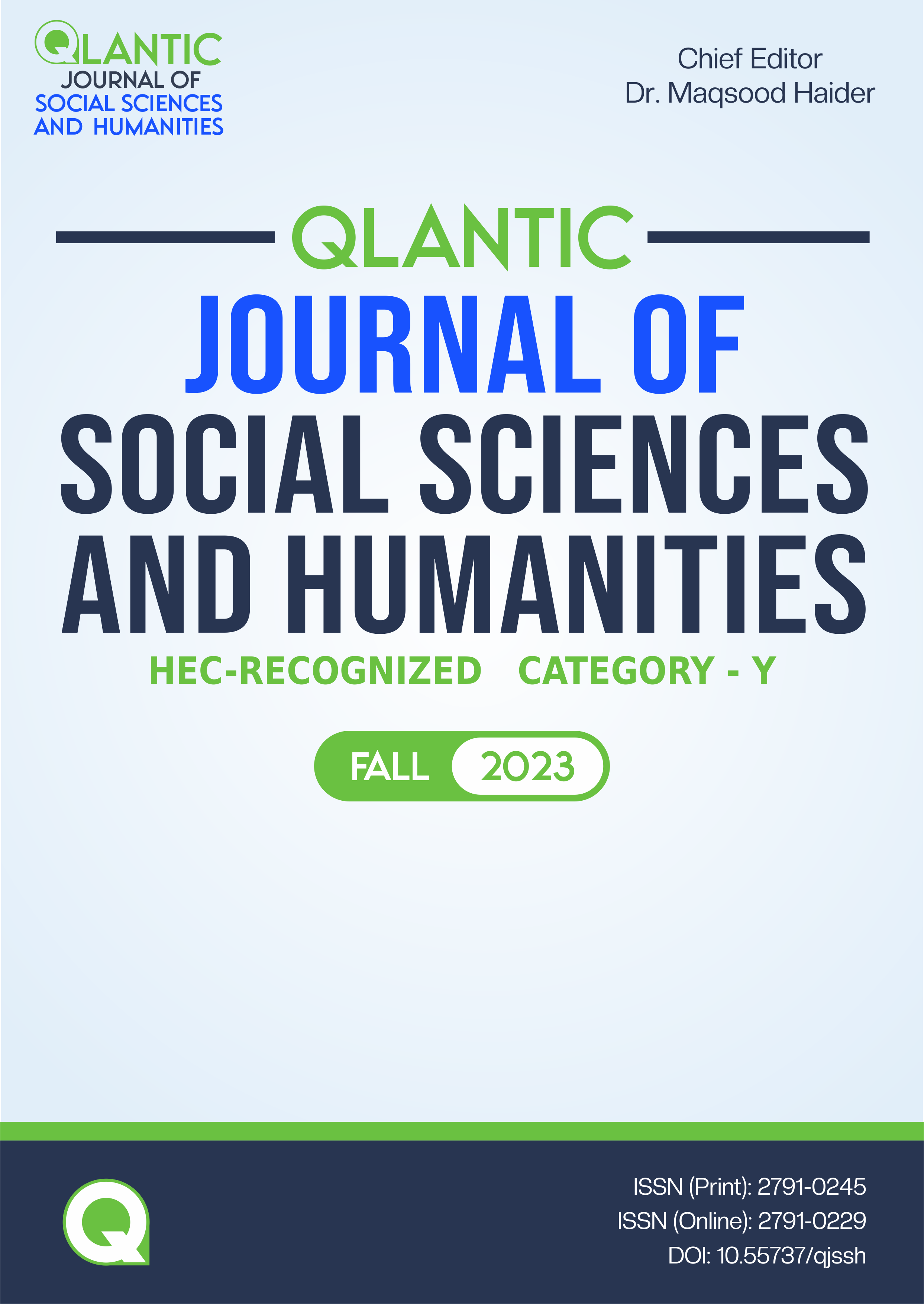Life of Communication Process: A Critical and Philosophical Approach Study of Communication Process
DOI:
https://doi.org/10.55737/qjssh.498899116Keywords:
Communication Process, Philosophical Developments, Ontology, Self-awarenessAbstract
Contextualizing Life of Communication is the study conducted to interpret the philosophical developments respective to critical approaches of Communication as a discipline, Communication as an idea, Communication as a process and Communication as a phenomenon, which results in the formulation of seven major traditions of Communication. This Research is an effort to identify the ontological existence and perspective of Communication, acclaiming it as a condition and state of mind in which we live all the Time consciously and unknowingly. The Research is an attempt to identify the importance of thinking, analyzing and understanding Imagination and self-awareness in the context of Communication. The methodological practice followed in this Research is Habermas's Public sphere theory, along with dialectal hermeneutical analysis through constructivism theory. The Research concluded that Imagination keeps Communication alive till it fulfils the purpose of its existence, and self-awareness is that purpose which needs to be attained through the precondition of thoughts (imaginations). For the sake of conclusion, a prospecting model derived from interpretations of various philosophers and Allama Iqbal’s Model of Life is presented in this Research.
References
Byrne, R. (2008). The Rational Imagination: How People Create Alternatives to Reality. The Behavioral and brain sciences. 30, 439-53, https://doi.org/10.1017/S0140525X07002579
Cleland, C. E., & Chyba, C. F. (2002). Defining ‘Life’. Orig Life Evol Biosph 32, 387–393. https://doi.org/10.1023/A:1020503324273
David, E. (2002). The communicative Imagination and its cultivation, Communication Quarterly, 50(1), 41-57. https://doi.org/101080/01463370209385645
De Luca, L. (2017). Imagination in the rational classroom: Considering alternatives to capitalism. The Journal of School & Society, 4(2), 78–83.
Demeter, M., & Tóth, J. (2012). Basic Researches In Communication and Media Studies. Kome, 1(1), 1-4. https://doi.org/10.17646/kome.2012.11
Durant, W. (2009). The story of philosophy: The lives and opinions of the great philosophers of the Western world. New York, NY: Simon and Schuster.
Flusser, V. (1992). Bodenlos: eine philosophische Autobiographie [Rootless: A philosophical autobiography], Bensheim and Düsseldorf, Germany: Bollmann.
Gehrke, P. J., & Keith, W. M. (2014). A Century of Communication Studies: The Unfinished Conversation (1st ed.). Routledge. https://doi.org/10.4324/9780203366912
Gerson, L. (2014, July 2). The Hermeneutics of Mystery in Plato. Academia.edu. https://www.academia.edu/7531441/The_Hermeneutics_of_Mystery_in_Plato
Grace, H. A. (1956). Confidence, Redundancy, and the Purpose of Communication. Journal of Communication, 6(1), 16-23. https://doi.org/10.1111/j.1460-2466.1956.tb02460
Holcombe, A. N. (1922). Public Opinion. By Walter Lippmann. (New York: Harcourt, Brace and Company. 1922. Pp. x, 427.). American Political Science Review. 16(3), 500-501. https://doi.org/10.2307/1943740
Hussain, M. (2020). The Impact of Effective Communication on Organizational Performance with Moderating Role of Organizational Culture. https://doi.org/10.13140/RG.2.2.22101.35048
Iqbal, M. (1930). The Reconstruction of Religious Thought in Islam. The Reconstruction of Religious Thought in Islam. https://www.sup.org/books/title/?id=21804
Kant, I., Critique of Pure Reason, P., Guyer & Wood, A. (1997). (trans.), Cambridge and New York: Cambridge University Press,
Kecskes, I. (2010). The paradox of Communication: Socio-cognitive approach to pragmatics. Pragmatics and Society, 1(1), 50-73. https://doi.org/10.1075/ps.1.1.04kec
Marcia á Cavalcante Schuback, M. (2006). The knowledge of attention. International Journal of Qualitative Studies on Health and Well-Being, 1(3), 133–140. https://doi.org/10.1080/17482620600884049
Novak- Marcincin, J., Gîfu, D., & Nicolescu, A. (2014). The Standard of Axes in Ontology of Communication. International Letters of Social and Humanistic Sciences, 41, 176–183. https://doi.org/10.18052/www.scipress.com/ilshs.41.176
Robbins, B. (2014, April 22). Joyful thinking-thanking: A reading of Heidegger’s “What is called thinking?” Academia.edu. https://www.academia.edu/2181567/Joyful_Thinking_Thanking_A_Reading_of_Heidegger_s_What_Is_Called_Thinking_
Rust, J. (2009). John Searle (continuum contemporary American thinkers). Continuum International Publishing Group Ltd.
Schiffer, M. B., & Miller, A. (1999). The Material Life of Human Beings: Artifacts, Behavior, and Communication, Routledge, London.
Shafe, O. (2021). The Classical Period (Plato And Aristotle) Presenter: Shafe Oluwagbenga Solomon (Sociology Of Education).
Shapiro, M. (2007). Values, Creativity, and Imagination in Generalizability. Communication Methods and Measures. 1, 207-213. https://doi.org/10.1080/19312450701434995
Spronck, S. (2016). The Instruction of Imagination: Language as a Social Communication Technology. Australian Journal of Linguistics, 39(1), 1–5. https://doi.org/10.1080/07268602.2016.1255121
Strawson, G. (2017). ‘We live beyond…any tale that we happen to enact’. The Subject of Experience, 106-122. https://doi.org/10.1093/acprof:oso/9780198777885.003.0006
The Mind's Eye. (n.d.). https://iai.tv/video/the-mind-s-eye
Tomkins, L., & Eatough, V. (2018). Hermeneutics: interpretation, understanding and sense-making.
Vardoulakis, D. (1970, January 1). Dimitris Vardoulakis, total Imagination and ontology in R. G. Collingwood. PhilArchive. https://philarchive.org/rec/VARTIA
Vlăduţescu, Ş., & Ciupercă, M. E. (2014). Next Flood Level of Communication Social Networks.
Vygotskiĭ, L. S. (1962). Thought and language. Cambridge: M.I.T. Press, Massachusetts Institute of Technology.
Walters, J. A. (1922, January 1). The purpose of life : Walters, James A, Archive. https://archive.org/details/purposeoflife00walt
Wilson, D., & Sperber, D. (2012). Meaning and relevance. Cambridge Core. https://www.cambridge.org/core/books/meaning-and-relevance/500D9D857CB3274BD23AF6FB381133B7
Published
Issue
Section
License
Copyright (c) 2023 Zarnab Noor Tariq

This work is licensed under a Creative Commons Attribution-NonCommercial 4.0 International License.





